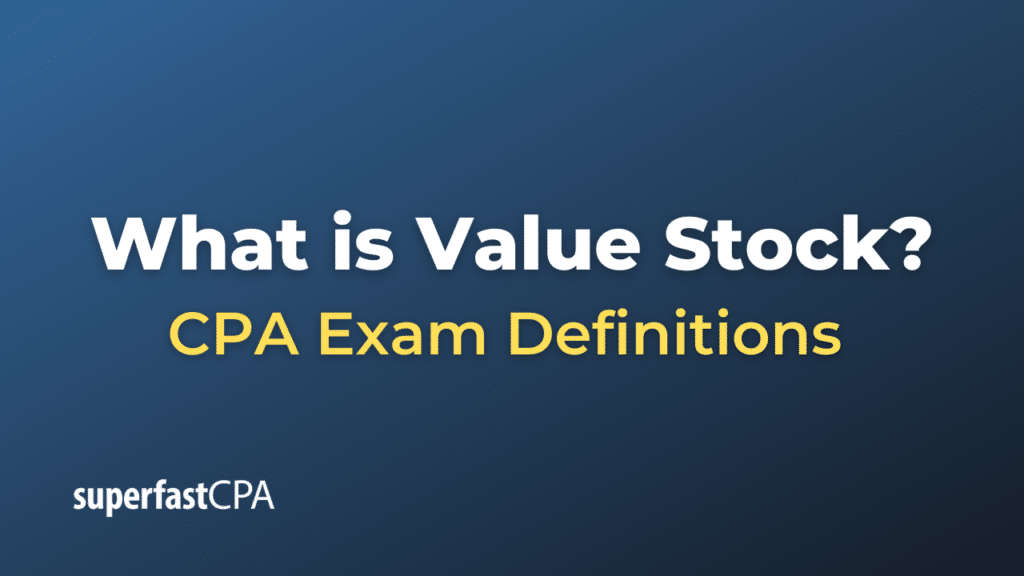Value Stock
A value stock is a share in a company that is considered to be undervalued based on fundamental analysis. Typically, value stocks are characterized by trading for prices that are low relative to their intrinsic value, which may be determined by metrics like earnings, dividends, growth rate, or book value. Investors who follow a “value investing” strategy seek to capitalize on these apparent market inefficiencies by purchasing stocks they believe are undervalued, with the expectation that their price will eventually rise to more accurately reflect the company’s true worth.
Characteristics of Value Stocks:
- Low Price-to-Earnings (P/E) Ratios : Often, value stocks have lower P/E ratios compared to other companies in the market or their industry.
- High Dividend Yields: Many value stocks pay dividends, and they often have higher-than-average dividend yields.
- Low Price-to-Book (P/B) Ratios : Value stocks may have low P/B ratios, meaning their market value is close to or even below their book value.
- Strong Fundamentals: Despite their low valuation metrics, many value stocks are fundamentally sound companies with stable earnings, strong balance sheets, and effective management.
- Underperformance in the Market: These stocks often underperform in the market due to being out of favor, either because they operate in an unpopular industry or face temporary setbacks.
- Less Volatility : Generally, value stocks are less volatile than growth stocks and may perform better during economic downturns.
Example of Value Stock
Let’s take a real-world example of a value stock using hypothetical figures to illustrate the concept.
Example: Johnson & Utilities Co.
Johnson & Utilities Co. is a utility company with a long history of stable earnings and good management. The company operates in an industry considered less glamorous than, say, technology or biotech, making it often overlooked by investors seeking rapid growth.
Key Metrics (Hypothetical):
- Stock price: $50
- Earnings per share (EPS) for the last 12 months: $5
- Dividend yield: 4%
- Price-to-Earnings (P/E) ratio: 10 (calculated as $50 stock price / $5 EPS)
- Price-to-Book (P/B) ratio: 1.2
Investment Scenario:
- Low P/E Ratio: Johnson & Utilities Co. has a P/E ratio of 10, which is significantly lower than the market average, indicating that it may be undervalued.
- High Dividend Yield : The company has a dividend yield of 4%, higher than the market average, providing investors with consistent income.
- Low P/B Ratio: The P/B ratio of 1.2 suggests that the stock is trading close to its book value, which could be another sign of undervaluation.
- Strong Fundamentals: The company has a track record of stable earnings, strong cash flow, and competent management.
- Industry: The utility sector is generally considered less volatile than the market as a whole, which can be an attractive feature for conservative investors.
An investor following a value strategy might look at these metrics and conclude that Johnson & Utilities Co. is a good buy. The low P/E ratio and high dividend yield, combined with strong fundamentals, suggest that the stock may be undervalued. By purchasing shares of this company, the investor hopes to benefit from both the stock’s potential capital appreciation and the dividend income.
As time goes on, if the market begins to recognize the company’s true value, the stock price may go up, providing the value investor with a good return on investment. Alternatively, even if the stock price remains somewhat stable, the investor can still benefit from the regular dividend payments.
It’s important to note that value investing involves thorough research and a long-term perspective. While the metrics might suggest that a stock is undervalued, there are always risks involved, and it’s crucial for investors to do their own due diligence.













